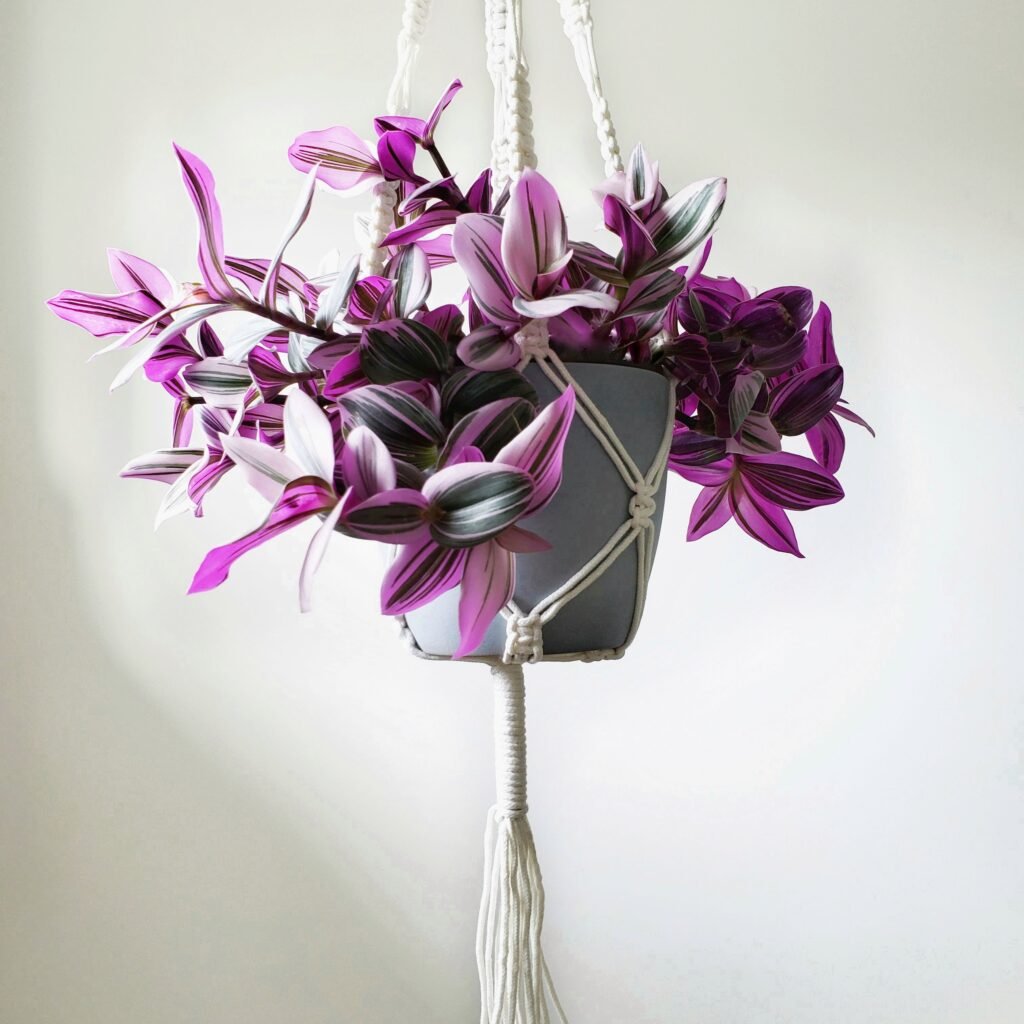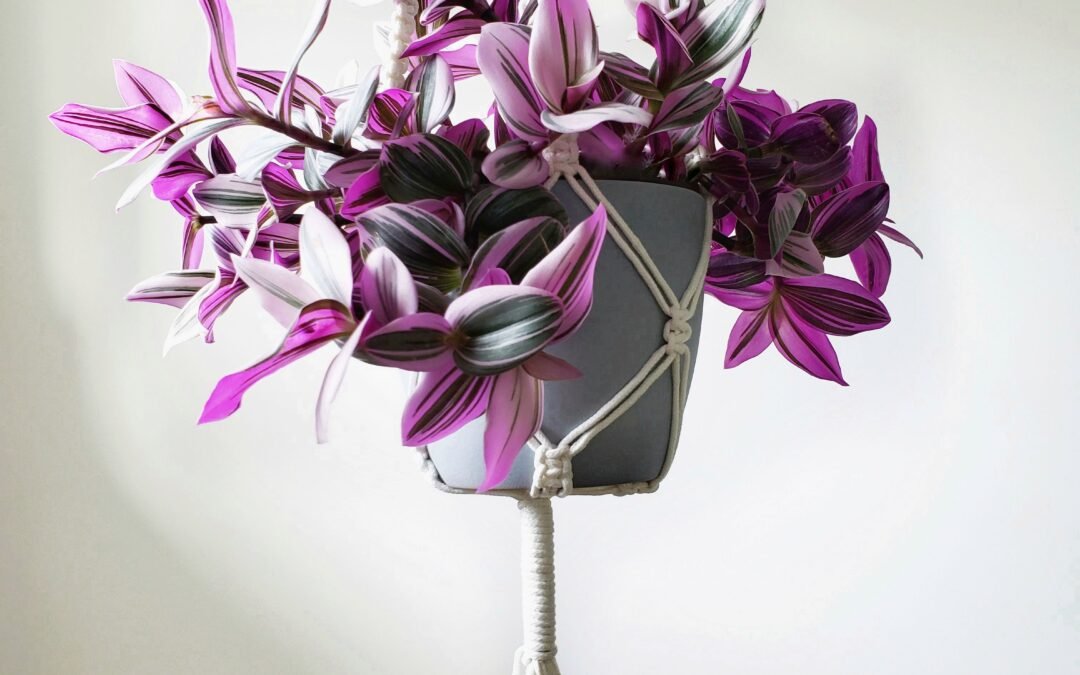If you have a shortage of space and can’t find a proper place for adding one more houseplant on your window sill, kitchen counter, and table then you are landing in the right place. Hanging or trailing plants can brighten up your space and add a new natural and creative look to your kitchen. If you have fur babies who like to nosh on houseplants then hanging plants are best for your pet’s jumping.
If you have the urge to hang your pot from the wall, make sure to fix a stud or joist in the wall before drilling. You can use a plant hook with a toggle bolt in the absence of a stud. Moreover, joists for hanging pots in the wall but always use drywall anchors that can tolerate a specific weight limit of at least 20 pounds. Don’t neglect your green friends after hanging them because your green friends still need a sufficient amount of sunlight, watering, and attention.
Pink Tradescantia | Trailing Plants

Pink Tradescantia is one of the gorgeous indoor trailing plants that have different unique common names like Wandering Jew, Wandering Dude, Spiderwort, and Inch Plant. The botanical name of pink Tradescantia is Tradescantia albiflora.
It earned its common name Wandering Jew because it scatter rapidly with sections of the stem in different sections.
It loves to live in a room that has bright indirect light, moist soil, and high humidity. There are 4 pink and lilac variegated Tradescantia like Tradescantia fluminensis tricolor, quadricolor, Tradescantia bubblegum, and Tradescantia Nanouk. All the varieties of Tradescantia are ever-growing. If you can provide proper care to your lovely plant, it will bloom beautiful pink and purple flowers in the reward.
How to grow and care for Pink Tradescantia?
- Place the pink Tradescantia in bright indirect sunlight and at a moderate temperature otherwise pink coloration of the Tradescantia will fade and turn a green color.
- Exclude all dark green leaves from the plant. If you are not pruning them at the proper time, they will take charge of your whole pink plant.
- If you notice any brown spots on pink leaves, it is an alarming point for you that your beautiful plant face sunburn and direct sunlight are scorching the beauty and tenderness of pink Tradescantia. It is also a sign of your plant requires more humidity.
- If the pink color of your plant fades and growth gets sluggish, it is a sign for you that your plant can’t get enough amount of light. The perfect place for your sensitive plant is an east or west- facing window.
- Don’t water the plant with open-heart and keep drainage holes in the pot that permit all additional water to drip out of the bottom. Despite this, you can purchase a moisture meter for your plants.
Burro’s tail

The botanical name of Burro’s tail is Sedum morganianum. This cactus-like indoor potted succulent with fleshy green leaves is one of the trailing plants that prefer hanging baskets or high spots for living. This captivating succulent loves bright indirect sunlight and moist and nutrient-rich soil for thriving. This Succulent has green-grey or blue-green leaves which have a little knob-like look.
How to grow and Care for your Burro’s tail?
- This drought-tolerant plant is best for tropical regions.
- Like other succulents, it will love to thrive in sandy soil or pre-mixed cactus soil.
- Like other succulents, it will require to report it only once after a few years.
- It will do best in bright indirect light, so, keep it in a sunny spot or near a window.
- If the green leaves of Burro’s tail turn yellow, then place it in a spot where it can get sufficient sunlight.
- If you feel that plump leaves of plants turn into crinkle leaves, it is the best time to water your green friend.
- Keep drainage holes in the pot that permit all additional water to drain out of the bottom. If you have no drainage holes in the pot, you must put two layers of gravel and rocks at the bottom of the pot or container.
String of Dolphins

If you’re looking for striking, unique, and stylish trailing plants or succulents for enhancing the beauty of your kitchen. then you never find the best option than a string of dolphins. The botanical name of this hanging plant is Senecio Peregrenius. You can say it dolphin necklace because of its shape. This plant has succulent blue-green leaves that each resemble a tiny iconic dolphin with two side-flippers that are arching. Everyone can be falling in love with it after seeing it once because of its ample cuteness and lovely shape. The blue-green leaves of a string of dolphins have long-hanging tendrils. Sometimes a string of dolphins blooms creamy-white flowers like small daises for making your day.
How do grow a string of dolphins at Indoor?
- The tiny dolphin-shaped leaves of this beautiful succulent can forfeit their stylish look because of overwatering. If you notice the shape of leaves and dolphin strings changes. Then stop watering until the soil is completely thirsty and dolphins become soft. In a very short period, the leaves of dolphins will welcome you with curved looks like tiny and cute dolphins diving out of the water.
- Do stem cutting at the proper time because stem cutting is the best propagation method to grow and enhance the numbers of dolphins.
- Use liquid organic fertilizer for a string of dolphins once every six to eight weeks from spring to fall instead of the winter season.
- This trailing succulent loves a warm and sunny climate and moderate humidity level for thriving.
String of Bananas

A string of Bananas (Senecio radicans) has a close relationship with a string of pearls. These trailing plants and low-maintenance succulents are popular among people for their growing speed. They are delightful foliage and glossy banana-shaped leaves that thrive on long-hanging tendrils. A string of Bananas is the best green friend for beginners. Native to South Africa, it can’t tolerate the freezing climate.
How to Care for Your String of Bananas?
- You can place it where it can get enough indirect light in the hanging pot to indicate charming and outstanding long trails of this succulent.
- If this succulent does not receive adequate light. It will become lanky and banana-shaped leaves will get substantially more dispersed throughout the stem. It may become sluggish in growth due to insufficient light.
- Make sure to keep it in direct sunlight, particularly in the summer month.
- Just be sure to let dry the soil before watering again. You should always use a pot with drainage holes for a string of bananas which assists to avert root rot.
- A string of Bananas loves well-drained soil for thriving. You can use premixed cactus or succulent soil to prepare the room for your String of bananas.
String of Pearls

A string of pearls plant (Senecio rowleyanus) is a remarkable, vining, and trailing succulent that is well-known for its long trailing stems and small pea-shaped leaves. It belongs to the Asteraceae family and is native to East Africa. It looks in the hanging basket like a necklace of rubies or a rosary string of beads with glossy pea-like foliage coming down towards the ground.
This outstanding succulent can become the center of attraction in your kitchen. Thin pencil or thread-like stems and round pearl-like leaves make this houseplant unique among trailing plants. You can call your green friend the name of a string of peas or a rosary vine. The string of pearls blooms white flowers with a cinnamon-like scent in the spring season. It is harmful to humans and your cute fur babies but it has no particular disease problems.
How to grow and care for your string of pearls?
- A string of Pearls can thrive on direct and indirect sunlight. They can do best in direct sunlight during the gentle morning hours.
- Make sure to change the position of a string of pearls and keep it in bright indirect sunlight during the brutal afternoon hours.
- Well-drained sandy soil and premixed cactus soil are perfect for thriving the string of pearls.
- Keep drainage holes in the pot that permit all additional water to drain out of the bottom. If you have no drainage holes in the pot, you must put two layers of gravel and rocks at the bottom of the pot or container.
- Terra Cota or Clay pots can also assist in drying off the soil’s excess moisture.
- A string of pearls loves growing in slightly moist soil during the spring and summer while slightly dry soil is in the winter season.
- If you feel the soil is dry by touching and round pearl-like leaves look flattening. It is a good sign for you that your lovely green friend is thirsty.
- If you notice the leaves of a string of pearls look shriveling and lethargic, it may indicator of overwatering or underwatering.
- If you notice the glossy green color of leaves turns yellow or gray, it is an alarming situation for you to keep your plant away from insects.


